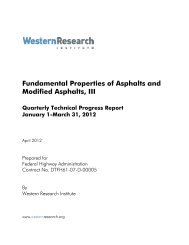Fundamental Properties of Asphalts and Modified Asphalts, III
Fundamental Properties of Asphalts and Modified Asphalts, III
Fundamental Properties of Asphalts and Modified Asphalts, III
Create successful ePaper yourself
Turn your PDF publications into a flip-book with our unique Google optimized e-Paper software.
KAO Gripper. The minor resonance was not assigned, but is assumed to be due to a dimer <strong>of</strong> the<br />
2-ethyl hexanol phosphate formed during preparation <strong>of</strong> the antistrip. The spectra <strong>of</strong> the Innovalt<br />
W <strong>and</strong> KAO gripper show partial hydrolysis <strong>of</strong> the PPA caused by residual water which is<br />
present in the antistrip agents. This is shown by the increase <strong>of</strong> the phosphoric acid resonance at<br />
~1.7 ppm relative to the phosphate ester resonance at ~0.7 pm with time <strong>of</strong> setting.<br />
There do not appear to be any reactions between the Innovalt W <strong>and</strong> KAO Gripper phosphate<br />
ester antistrip agents <strong>and</strong> PPA. Presumably, there would not be any such reactions when the<br />
antistrip <strong>and</strong> PPA were added to asphalt. To test this assumption, Innovalt W <strong>and</strong> KAO Gripper<br />
antistrips were added to asphalt AAM followed by PPA (115%) addition (figure 2-5.7). Both the<br />
antistrips <strong>and</strong> PPA were added at a level <strong>of</strong> 1 wt %. The purpose <strong>of</strong> these experiments was<br />
tw<strong>of</strong>old: (1) to determine if 31 P NMR can detect signals at the 1% level in a reasonable amount<br />
<strong>of</strong> time, <strong>and</strong> (2) to determine if there might possibly be reactions between the PPA <strong>and</strong> antistrip<br />
in asphalt.<br />
In the case <strong>of</strong> the phosphate ester antistrip agents, there is a single resonance at a chemical shift<br />
(~1.7 ppm) near that <strong>of</strong> phosphoric acid (~1.4.ppm). In both cases spectra with reasonable<br />
signal-to-noise, S/N, ratios were obtained after 3 h <strong>of</strong> signal averaging. When added to asphalt<br />
in the presence <strong>of</strong> PPA, the ester antistrip resonance could not be resolved from that <strong>of</strong><br />
phosphoric acid at the resolution <strong>of</strong> the WRI magnet. Under high resolution conditions, it is<br />
expected that these resonances could be resolved.<br />
Innovalt W in<br />
PPA (115%)<br />
At 99 h<br />
Innovalt W in<br />
PPA (115%)<br />
at 0 h<br />
Innovalt W neat<br />
30 25 20 15 10 5 0 -5 -10 -15 -20 -25 -30 -35 -40 -45 -50 30 25 20 15 10 5 0 -5 -10 -15 -20 -25 -30 -35 -40 -45 -50<br />
Phosphorous Chemical Shift, ppm Phosphorous Chemical Shift, ppm<br />
Figure 2-5.6. 31 P NMR spectra <strong>of</strong> phosphate ester antistrips, neat <strong>and</strong> with PPA (115%)<br />
at different times.<br />
64<br />
KAO Gripper in<br />
PPA (115%)<br />
At 360 h<br />
KAO Gripper<br />
In PPA (115%)<br />
At 0 h<br />
KAO Gripper neat





